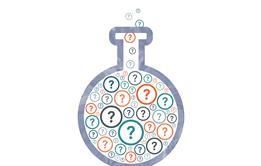Six mystery chemicals wait for students to identify them
The students are contacted by the data collection manager for SpectraSchool. There has been a flood and the labels have come off a number of bottles. The students are to analyse various spectra (IR, mass spec, 1 H and 13 C NMR) and use these, together with melting point determination, to identify the six unknowns.
Pre-lab questions
(Remember to give full references for any information beyond A-level that you find out)
- Give the structures and the melting points of the following six compounds:
- caffeine
- benzoic acid
- paracetamol
- methyl ethanoate
- 2-hydroxybenzoic acid
- propanoic acid
- The melting point of a pure compound is known to be 95-96 ◦C. How would the melting point differ if this compound is contaminated with 5% of an impurity?
- Carboxylic acids are weak acids but they are stronger than carbonic acid. Therefore carbon dioxide is released when they are reacted with carbonates or hydrogen carbonates (bicarbonates).
Decide which of the compounds in question 1 would release carbon dioxide from carbonates or hydrogen carbonates and write equations to represent any chemical reactions which would occur.
- Two common solvents in NMR are deuterated chloroform (CDCl3) and deuterated dimethyl sulfoxide, DMSO [(CD3)2 SO2].
- What is a deuterium atom?
- In their pure form, both of these solvents are invisible in 1 H NMR. However it is common to see residual solvent peaks in the 1 H NMR at dH 7.27 ppm for CDCl3 and 2.5 ppm for DMSO. Explain why?
- As both of these solvents contain a carbon atom, residual solvent peaks are usually evident when these solvents are used when measuring 13 C NMR spectra. Find the chemical shifts and multiplicity (splitting pattern) for the residual solvent peaks observed for each solvent.
- In the mass spectrometer, fragmentation of the molecular ion of paracetamol produces a peak with m/z 43. Identify the fragment responsible for the peak, and write an equation for the fragmentation process.
Equipment
Chemicals
- Benzoic acid [Harmful] labelled Sample A
- 2-hydroxybenzoic acid [Harmful] labelled Sample B
- Propanoic acid [Corrosive] labelled Sample C
- Methyl ethanoate [Highly flammable; Irritant] labelled Sample D
- Paracetamol labelled Sample E
- Caffeine labelled Sample F
- Sodium carbonate [Irritant] or sodium hydrogen carbonate [Low hazard]
Apparatus
- Access to a melting point apparatus
- Melting point tubes
- Test tubes
- Spatula
- Disposable pipettes
- Universal Indicator solution
Health, safety and technical notes
- Read our standard health and safety guidance.
- Wear eye protection
- Benzoic acid is harmful see CLEAPSS Hazcard HC013a
- 2-hydroxybenzoic acid is harmful see CLEAPSS Hazcard HC052
- Propanoic acid is corrosive see CLEAPSS Hazcard HC038b
- Methyl ethanoate is highly flammable and an irritant see CLEAPSS Hazcard HC043a
- Sodium carbonate is an irritant see CLEAPSS Hazcard HC095a
- Sodium hydrogen carbonate is low hazard.
More resources
Read this job profile to find out how scientific associate, Christopher uses NMR to identify the chemical structure of new and unknown compounds.
Downloads
Compound confusion teacher & tech sheet
PDF, Size 0.47 mbCompound confusion student sheet
PDF, Size 1.07 mb
Additional information
This resource was developed by Catherine Smith, RSC School Teacher Fellow at the University of Leicester 2011 – 2012, produced as part of the National HE STEM Programme.

Problem based practical activities

Discover how chemistry can relate to real world problems, so students can put their science knowledge into context.
- 1
- 2
- 3
- 4
- 5
- 6
- 7
- 8
 Currently
reading
Currently
reading
Compound confusion
- 10
- 11











































No comments yet